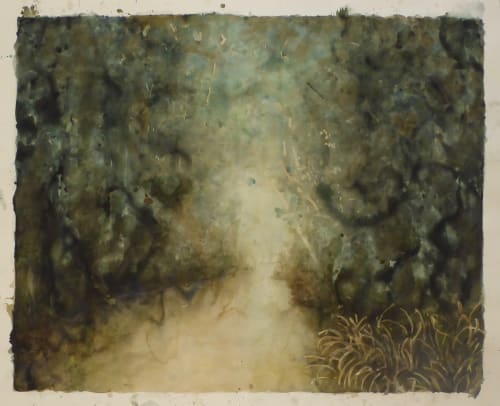"Our Sublime Coexistence: Thinking with Ripley Whiteside's landscapes of climate change"
by Roksana Filipowska, PhD, New Haven, Connecticut
Imagine a grove of trees. Perhaps it is a familiar grove, well-worn with footpaths and memories. Maybe the imaginary grove is an assemblage of trees, an image of arboreal signifiers with sketchy outlines lacking particularity. But, what does the life of this grove look like? Instead of focusing on a static view of the trees, you may imagine the soil that supports their roots, the symbiotic relationship between fungi and root systems for accessing scarce nutrients and protection against parasites, or the water that enters roots through osmosis to travel up the bark and into the high-reaching leaves. Imagining the life of trees breaks open the boundaries of their image. Whereas the grove is framed as something to behold in the image, life emerges as the various interdependent, and often invisible, processes that connect to increasingly larger, and more complex, ecosystems.
What if imagining the life of the grove extends to the impacts of climate change? By considering the source of the water as well as the toxins that seep into soil, the exercise turns noxious: the trees pump polluted water and photosynthesize contaminated air. Even as the life processes continue, the grove's future appearance becomes uncertain. What new configurations of flora will emerge as biota and man-made toxins enmesh? Contemplating this weird and open-ended future of the grove's ecosystem within climate change is an aesthetic exercise. Though it is still broken, the image returns. Its shards take on a mirror-like quality as the image reflects flashes of a dark ecology, a strange entanglement of matter.
Philosopher Timothy Morton speculates that ecological awareness takes the form of a strange loop, or a Mobiüs strip. To enter its curious logic, is to encounter one's own implicitness. Ecological awareness positions the human as implicit in the crime of climate change, while also discarding the human as neither a cohesive nor privileged subject. For Morton, humans are among many geophysical forces and, so, epistemology transmutes into ecognosis, where knowledge shifts into an uncanny, looped letting-be-known, or something resembling coexistence. In his landscape paintings, Ripley Whiteside grapples with his own implicitness in climate change, as well as the horror and perversity in finding aesthetic pleasure in sites of global warming. Operating within the strange loop of ecological awareness, Whiteside's watercolors of abstract landscapes reflect an interdependence that is as sublime as it is pervasive.
Landscape painting is a weighty genre. It has grown heavy over the centuries, with painters obscuring a site's indigenous origins or the people laboring to maintain the land in order to arrive at an aesthetically pleasing image. In this way, every landscape-no matter how precisely rendered-is an abstraction of an ecosystem, a complex network of living organisms and nonliving components, as well as the stories that frame how humans experience their entanglement within this codependent system. The landscape painter is part of this ecosystem, too. Whether picturesque, naturalistic, or sublime, the image bears the painter's fears and desires as they navigate their position within the world. Framing the landscape as a scene for the viewer to behold, the painter abstracts interdependence into the ruse of human dominance. The genre is, therefore, troublesome: the contemporary landscape painter doesn't just encounter the historical weight of the genre, but the subterfuge of human exceptionalism and its accompanying long-term habit of exploiting the land.
Whiteside turns the logic of the landscape painting in on itself, transforming the genre into a loop. In Dawn, for instance, the daily, and often photographed, event of a sunrise strikes a nefarious tone. A glowing orb illuminates a murky horizon. Its warm yellow takes on a chemical hue when blended with earthy browns of the riverbank. This indeterminacy between light and mass, or figure and ground, makes much of the image illegible, as though one is squinting to see the landscape through a thick layer of smog that blankets all that it touches. Sunlight delineates individual tree branches while obliterating others, further complicating the ontology of the bright white source of light at the center of the image. Perhaps the river is reflecting the radioactivity of an explosive bomb rather than the light of the life-sustaining sun.
Whereas painters usually depict a landscape through the medium of paint, Whiteside is interested in how art materials participate within ecosystems. He collects black walnut husks that have fallen from trees to craft his own ink, which makes his practice both sustainable and site-specific. Watercolor is often evaluated based on the painter's control of the paint. Whiteside, meanwhile, applies water generously so the ink pools and colors blend into unexpected mixtures. Whereas abstraction in the landscape genre has served as a tool to naturalize human control over their surroundings, Whiteside's landscapes become abstract through the unrestrained flow of water. Jeff Wall has observed a "liquid intelligence" in such wet processes as early chemical photography, as well as washing and dissolving, noting that water embodies memory-traces of transformation. In Whiteside's paintings, the liquid intelligence of ink evokes the incalculability of climate change or water's potential to cleanse and purify. Perhaps what is most strange about these landscapes is that their transformation is ambiguous, leaving their future open-ended and unknowable.

